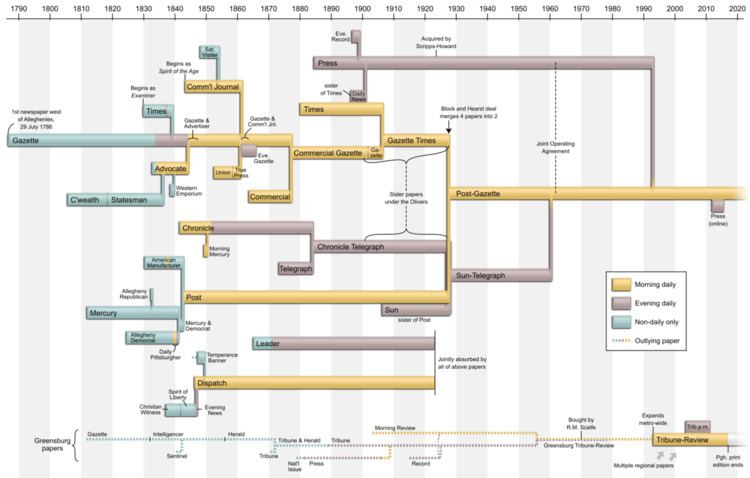Format Broadsheet Language English | Founded June 23, 1884 | |
 | ||
Type Afternoon Daily newspaper (historical)
Afternoon Daily online newspaper Owner(s) E. W. Scripps Company (1924–1992)
Block Communications (2011–present) Ceased publication May 17, 1992 (in print)
January 18, 1993 (sold) | ||
The Pittsburgh Press (formerly known as The Pittsburg Press), published from 1884 to 1992, was a major afternoon daily newspaper in Pittsburgh, Pennsylvania, US. It was one of many competing city newspapers published prior to the First World War including The Hearst Corporation owned Pittsburgh Sun-Telegraph, the Pittsburgh Dispatch, and the Block Communications owned Pittsburgh Post-Gazette. At one time, the Press was the second largest newspaper in Pennsylvania, behind only the Philadelphia Inquirer. For four years starting in 2011, the brand was revived and applied to an afternoon online edition of the Post-Gazette.
Contents
Originally The Evening Penny Press, the title changed to The Pittsburg Press in 1887. The paper referred to the city and its sports teams as "Pittsburg" until August 1921, when the letter H was added.
Joint operating agreement
In 1923, the Press was acquired by the Scripps-Howard Syndicate. During the 1960s, it entered into a Joint Operating Agreement (JOA) with the competing Pittsburgh Post-Gazette. The Post-Gazette had previously purchased and merged with the Hearst Corporation's Pittsburgh Sun-Telegraph leaving just itself and the much larger Pittsburgh Press.
The JOA was to be managed by the Pittsburgh Press owners (E. W. Scripps Company) as the Press had the larger circulation and was the stronger of the two papers.
Under the JOA, the Post-Gazette became a 6-day morning paper, and the Pittsburgh Press became a 6-day afternoon paper in addition to publishing the sole Sunday paper.
This arrangement was in effect until Scripps began bargaining with the Teamsters union, whose contract with the Press expired in 1991. After a very lengthy Teamsters strike in 1992, Scripps sold the Press to Block Communications, the owners of the much smaller JOA paper, the Post-Gazette, who promptly ceased printing the Press and folded it into the Post-Gazette. In return, Scripps received The Monterey County Herald. The sale required a ruling by the U.S. Department of Justice as the JOA was regulated by the Newspaper Preservation Act of 1970.
The outcome was a surprise to many people in Pittsburgh, as the Press had a much higher profile, and was the larger of the two JOA papers, both in company size and in circulation. Before the 1992 strike, many assumed that the smaller Post-Gazette would cease publication when the JOA expired. The departure of the Press also meant that Scripps was exiting the Pittsburgh market entirely.
Sunday edition
The Sunday edition was popular with readers because of its two comics sections, which included Prince Valiant, Peanuts, Dick Tracy, Blondie, Gordo, Priscilla's Pop, and Jest in Pun, among many others, and because of the four inserted magazines: Press TV Guide, Family, Roto, and Weekly.
Resurrection online
Block Communications announced on November 14, 2011 that it was bringing back the Press in an online-only edition for the afternoon, effective immediately. David Shribman, executive editor of the Post-Gazette, explained his paper's motivation for reviving the Press name, citing the fact that his newspaper still received letters to the editor addressed to the Press instead of the Post-Gazette, and that despite nearly 20 years since its last publication Pittsburgh natives still talked about the Press on a regular basis. Although published electronically, the new Press was formatted with a fixed layout replicating that of a traditional printed newspaper. The experiment ended with the issue of September 25, 2015.
